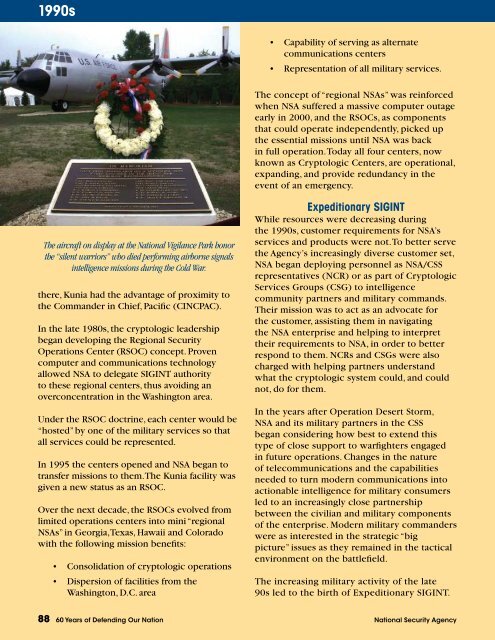National Security Agency - The Black Vault
National Security Agency - The Black Vault
National Security Agency - The Black Vault
- No tags were found...
You also want an ePaper? Increase the reach of your titles
YUMPU automatically turns print PDFs into web optimized ePapers that Google loves.
1990s<br />
1990s<br />
<strong>The</strong> aircraft on display at the <strong>National</strong> Vigilance Park honor<br />
the “silent warriors” who died performing airborne signals<br />
intelligence missions during the Cold War.<br />
there, Kunia had the advantage of proximity to<br />
the Commander in Chief, Pacific (CINCPAC).<br />
In the late 1980s, the cryptologic leadership<br />
began developing the Regional <strong>Security</strong><br />
Operations Center (RSOC) concept. Proven<br />
computer and communications technology<br />
allowed NSA to delegate SIGINT authority<br />
to these regional centers, thus avoiding an<br />
overconcentration in the Washington area.<br />
Under the RSOC doctrine, each center would be<br />
“hosted” by one of the military services so that<br />
all services could be represented.<br />
In 1995 the centers opened and NSA began to<br />
transfer missions to them. <strong>The</strong> Kunia facility was<br />
given a new status as an RSOC.<br />
Over the next decade, the RSOCs evolved from<br />
limited operations centers into mini “regional<br />
NSAs” in Georgia, Texas, Hawaii and Colorado<br />
with the following mission benefits:<br />
• Consolidation of cryptologic operations<br />
• Dispersion of facilities from the<br />
Washington, D.C. area<br />
• Capability of serving as alternate<br />
communications centers<br />
• Representation of all military services.<br />
<strong>The</strong> concept of “regional NSAs” was reinforced<br />
when NSA suffered a massive computer outage<br />
early in 2000, and the RSOCs, as components<br />
that could operate independently, picked up<br />
the essential missions until NSA was back<br />
in full operation. Today all four centers, now<br />
known as Cryptologic Centers, are operational,<br />
expanding, and provide redundancy in the<br />
event of an emergency.<br />
Expeditionary SIGINT<br />
While resources were decreasing during<br />
the 1990s, customer requirements for NSA’s<br />
services and products were not. To better serve<br />
the <strong>Agency</strong>’s increasingly diverse customer set,<br />
NSA began deploying personnel as NSA/CSS<br />
representatives (NCR) or as part of Cryptologic<br />
Services Groups (CSG) to intelligence<br />
community partners and military commands.<br />
<strong>The</strong>ir mission was to act as an advocate for<br />
the customer, assisting them in navigating<br />
the NSA enterprise and helping to interpret<br />
their requirements to NSA, in order to better<br />
respond to them. NCRs and CSGs were also<br />
charged with helping partners understand<br />
what the cryptologic system could, and could<br />
not, do for them.<br />
In the years after Operation Desert Storm,<br />
NSA and its military partners in the CSS<br />
began considering how best to extend this<br />
type of close support to warfighters engaged<br />
in future operations. Changes in the nature<br />
of telecommunications and the capabilities<br />
needed to turn modern communications into<br />
actionable intelligence for military consumers<br />
led to an increasingly close partnership<br />
between the civilian and military components<br />
of the enterprise. Modern military commanders<br />
were as interested in the strategic “big<br />
picture” issues as they remained in the tactical<br />
environment on the battlefield.<br />
<strong>The</strong> increasing military activity of the late<br />
90s led to the birth of Expeditionary SIGINT.<br />
While NSA continued to support military<br />
customers from Fort Meade and field sites<br />
around the world, the <strong>Agency</strong> also began<br />
pushing the resources of the enterprise<br />
closer to the warfighter. NSA personnel began<br />
joining their CSS colleagues in deployments<br />
with military forces, providing tailored SIGINT<br />
support to operations around the world.<br />
Like the Cryptologic Centers, the NCRs, CSGs,<br />
and Expeditionary SIGINT personnel ensured<br />
continuity of operations for NSA’s customers<br />
and increased NSA’s ability to provide tailored<br />
support in response to critical requirements.<br />
Enhanced <strong>Security</strong><br />
<strong>The</strong> 1990s also saw an increase in the level of<br />
physical security at NSA. Access became more<br />
restricted; no longer could family members<br />
and pizza delivery people get close to the<br />
fence line. After the Oklahoma City bombing<br />
in 1995, an NSA perimeter security fence<br />
was constructed to surround the entire Fort<br />
Meade campus. In addition, the NSA Police<br />
added a K-9 unit in 1998, which greatly<br />
improved the <strong>Agency</strong>’s capability to check<br />
for explosives during commercial vehicle<br />
inspections and assist in security patrols and<br />
emergency responses.<br />
Improving Computer <strong>Security</strong><br />
In the late 1990s, the NSA Systems and Network<br />
Attack Center (SNAC) tackled the difficult<br />
question of how best to improve the security<br />
level of personal computers and servers that<br />
were part of national security systems. This led<br />
to the need to discover software implementation<br />
flaws, probe operational networks for<br />
weaknesses, and develop guidance to harden<br />
systems against attack.<br />
<strong>The</strong> SNAC made security configuration<br />
guidance publicly available on NSA’s web page,<br />
and released guidance for the Department of<br />
Defense’s (DoD) Windows operating systems<br />
and Unix-like operating systems.<br />
Microsoft provided additional guidance<br />
with SNAC’s full cooperation and public<br />
recommendation. <strong>The</strong> settings from this effort<br />
were adopted as a baseline for the DoD and<br />
by the <strong>National</strong> Institute of Standards and<br />
Technology for its Federal Desktop Core<br />
Configuration. Through this effort the federal<br />
Regional <strong>Security</strong> Operations Centers, like the one in Hawaii pictured above,<br />
provide NSA with the redundancy needed in the event of an emergency.<br />
88 60 Years of Defending Our Nation <strong>National</strong> <strong>Security</strong> <strong>Agency</strong><br />
<strong>National</strong> <strong>Security</strong> <strong>Agency</strong> 60 Years of Defending Our Nation 89

















